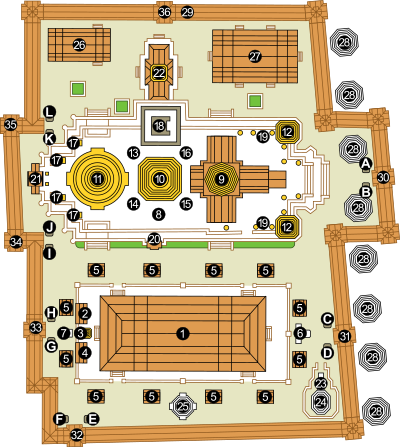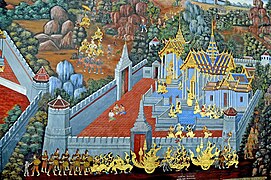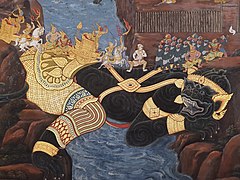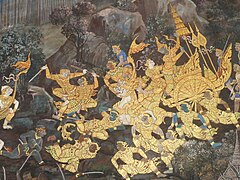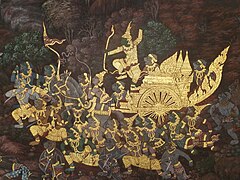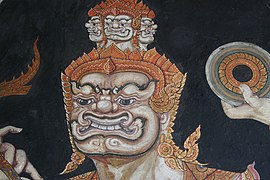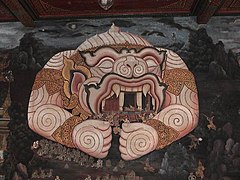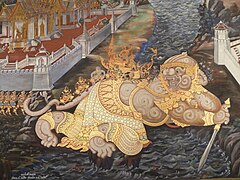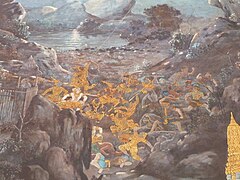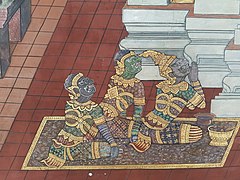User:HMGiovanniV/工作3
| 玉佛寺 | |
|---|---|
 自大皇宫外廷望向玉佛寺 | |
| 基本信息 | |
| 国家 | 泰国曼谷拍那空县 |
| 坐标 | 13°45′5″N 100°29′33″E / 13.75139°N 100.49250°E |
| 宗教 | 上座部佛教 |
| 開基 | 拉玛一世 |
| 竣工 | 1785年 |
| 地圖 | |
 | |
玉佛寺(泰語:วัดพระแก้ว 发音:[wát.pʰráʔ.kɛ̂ːw] (ⓘ),皇家轉寫:Wat Phra Kaeo),正式名称是帕西拉达那沙沙达兰寺(วัดพระศรีรัตนศาสดาราม Wat Phra Si Rattana Satsadaram),泰国扎克里王朝的王家佛寺,泰国佛教圣地,位于曼谷大皇宫内。寺内供奉泰国国宝帕佛陀大摩尼寶玉佛,玉佛寺亦因而得名。
玉佛寺始建于1783年,由扎克里王朝的开国之君拉玛一世下令修建,此后历代国王又不断修葺增建,以积攒福德、增进威望。作为大皇宫的御庙,玉佛寺是泰国唯一最高等级的特等王家寺院(พระอารามหลวงชั้นพิเศษ),在泰国宗教和政治上都享有独一无二的地位,是诸多王家仪式、国家典礼的举办地。同时,泰国历代王室亦将大量珍宝捐赠于此,并增修各式各样的亭塔楼阁,令玉佛寺积累了泰国历代王室的财富,各种风格形制的泰国传统宗教建筑汇集于此,是泰国宗教艺术成就的集大成之地。
历史
[编辑]
1782年4月6日,暹罗国王拉玛一世定都曼谷。新都位于昭披耶河东岸,和前朝鄭昭王的都城吞武里隔河对望,考虑到原吞武里王宫规模较小,且被黎明寺和莫利洛甲亚兰寺夹在中间,难以扩建,新王朝亦应有别于旧的吞武里王朝,拉玛一世于是筹划在曼谷修建新王宫[1][2]。
拉玛一世建成大王宫,并在周围修城筑池作为王城,称拉达那哥欣岛。根据暹罗传统,王宫内部应固定划出寺院区域,专供王室礼佛。寺院四周修围墙,从而和王宫其他的生活办公区域隔开。王家寺院虽然具备一座常规的洼寺所需的各种建筑和设施,但由于并不在僧人修行制度之内,故没有任何僧人入驻,只在重要仪式期间邀请其他寺院的僧人入内。这一传统在暹罗各个王朝都有传承,依次是:素可泰王国时期,素可泰王宫建玛哈泰寺;阿瑜陀耶王国时期,阿瑜陀耶王宫建帕喜善佩寺;吞武里王国时期,吞武里王宫建黎明寺[2]其中,玉佛寺的规划参考了阿瑜陀耶时代的帕喜善佩寺的设计和布局[3]。
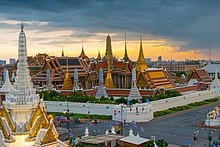
玉佛寺于1783年开工,正式名称是“帕西拉达那沙沙达兰寺”,意为“美丽圣宝本师教化寺[4]”。玉佛寺的位置定于王宫外廷东北角,其正殿是整个大王宫区域最早建成的砖石建筑,而在财力物力均不充足的拉玛一世时期,当时王宫内其他宫殿皆仍为木制。1785年2月或3月[a],暹罗王室举办盛典,将帕佛陀大摩尼寶玉佛从吞武里黎明寺渡河护送至玉佛寺。1786年,拉玛一世为新都曼谷授予正式名称,名称中便提及“玉佛居处[8]”。
从拉玛三世和拉玛四世时期起,玉佛寺历经历代国王修葺扩建。1831年,为预备1832年曼谷建城50周年纪念,拉玛三世下令重修玉佛寺。拉玛四世时期动工修缮,并在1882年拉玛五世时期,曼谷建城百年纪念时完工。之后在1932年和1982年,曼谷建城150周年纪念和200周年纪念,分别由拉玛七世和拉玛九世下令再加修缮[9][10][2]。
作为王家寺院,玉佛寺是王家举办佛教仪式的地方,包括加冕、受戒和僧王就任等。重大节庆期间,包括佛教的卫塞节、轉法輪日、万佛节,及扎克里王朝纪念日、春耕节、国王生辰、宋干节等其他节日,国王会亲自到玉佛寺参与庆典,或派亲信参加。此外,每年会举行三次玉佛更衣仪式[11]。除非举行重大仪式,玉佛寺连同大王宫的部分区域平日都对公众开放,是泰国负盛名的旅游目的地。
戒堂
[编辑]
玉佛寺的正殿称为圣戒堂(พระอุโบสถ),占地面积接近整个寺庙区域靠南的一半。四周修矮墙,墙周边建八座镇邪石亭,尖塔样式,安置八块外覆金箔的镇邪石。在泰国佛寺建筑传统中,戒堂四周的边界由镇邪石划出,代表此处是僧侣集结行业之划界[12]。
戒堂于拉玛一世时期的1783年动工,用于供奉玉佛,是寺院内较早建成的建筑。玉佛是由暹罗军队自老挝万象俘获,先移入昭披耶河西岸的黎明寺供奉,又在1785年经盛大仪式移祀至玉佛寺戒堂[a][12]。1831年,拉瑪三世主持工程,对戒堂外立面实施大修[13]。
外部
[编辑]
戒堂占地平面为长方形,单层大殿,正门朝东[3],四周修柱廊,支撑四层大屋檐。东西两端修门廊,向外延伸,并由额外的立柱支撑,共四十八根方柱,呈十二缺角形,边缘贴金,柱身镶嵌彩色琉璃,莲花柱头[14]。柱顶修斜撑支架,装饰成海蛇那伽的身形,蛇头朝下,喻指为佛陀遮风挡雨的目支邻陀[15]。屋檐覆蓝色、黄色和橙色琉璃瓦。屋顶两侧的山花上有华丽繁复的雕塑,描绘婆罗门教天神那罗延(或毗湿奴)骑乘金翅大鹏迦楼罗,后者双爪牵那伽蛇尾的形象。泰国文化传统将婆罗门教天神作为王权的象征,迦楼罗是天神的座驾,威力无穷、忠诚护主,亦出现在泰国国徽上。屋檐上挂着数百个贴金的小风铃,其上悬挂菩提叶形帆片[14]。
戒堂的外立面通体覆盖金箔和彩色琉璃,下修多层台基,需走阶梯入内。台基最底层覆蓝地花纹彩瓷,向上一层为莲花纹彩色琉璃,顶层为112尊迦楼罗执那伽蛇尾像,贴金并镶嵌琉璃,包围戒堂四周。戒堂东西两侧各开三扇门,外设矮台阶,门板有珍珠母贝螺钿神兽和草木图案,门楣装饰尖顶王冠。中央的门略大,仅供国王出入[14]。戒堂的墙壁很厚,靠内的门框上装饰有持剑或矛的守门天[16]。
戒堂外矗立着十二只铜狮,把守入口的通路,其形象仿照拉玛一世时期截获的高棉狮像[16]。
-
戒堂台基处装饰有112尊贴金迦楼罗像
-
戒堂台基覆青底花鸟瓷砖
-
戒堂东西两侧各开三扇门
-
高棉式铜狮
-
柱廊
-
金箔和彩色琉璃装饰
-
靠内的门框上装饰有持剑或矛的守门天
-
天花板为木制,漆成红色,有琉璃镶嵌的星形装饰和金水漏印花纹
内部
[编辑]玉佛寺内墙全部绘有壁画,以释迦牟尼的生平经历为主题。东面墙壁主要描绘了佛陀降魔的场景。天魔为阻止佛陀证悟,派魔军前来阻挠,佛陀持触地印,由土地女神帕媚托拉尼护佑。帕媚托拉尼的形象位于中央大门的正上方,她拧干打湿的头发,召来洪水淹没了魔军。玉佛身后的西面墙壁上描绘有大千世界的场面[17]。北面和南面的壁画按照章节逐行展开,窗户上方是佛陀生平故事;窗户之间是本生经故事,即佛陀前世的故事;北侧窗户下方描绘暹罗王室陆路游行的场面,南侧则是水路游行场面[18]。天花板为木制,漆成红色,有琉璃镶嵌星形装饰和金水漏印花纹。玉佛坐落在戒堂西端的多层平台上,并有众多佛像围绕[19]。
玉佛
[编辑]
玉佛(พระแก้วมรกต)的正式名称是“帕佛陀大摩尼寶玉佛”(พระพุทธมหามณีรัตนปฏิมากร),是玉佛寺的主佛像、镇寺之宝,玉佛寺因此而得名。玉佛高66厘米[20][21],持禅定印,结跏趺坐,碧玉石雕成,身着金衣[22]。佛像坐落在一布沙博式贴金木制宝座上,为金尖顶亭,下有多层金字塔式基座,为拉玛一世时期雕成。拉玛三世时期,将拉玛二世的遗骸埋置在宝座下,基座也随之加高[23]。
玉佛有众多其他佛像及各式珍宝围绕,为历代王室捐赠于此。例如,其中有1908年捐赠的欧洲大理石花瓶和大理石宝座[18]。
其他佛像
[编辑]在玉佛周围,又放置有各式大小佛像,由历代国王主持铸造并捐赠。
面对玉佛向内看,帕佛陀约华朱拉洛(พระพุทธยอดฟ้าจุฬาโลก)位于玉佛右前方,高3米,铜铸贴金,直立姿态,双手持施無畏印[24][25]。佛像衣着华丽,头戴王冠,有项链、戒指、臂环等饰品,是阿瑜陀耶时代至扎克里时代早期御造佛像风格,于1841年由拉玛三世主持铸造,目的是纪念其祖父拉玛一世,“帕佛陀约华朱拉洛”亦自此成为拉玛一世通銮的正式称呼[23]。
帕佛陀洛罗那帕莱(พระพุทธเลิศหล้านภาลัย)位于玉佛左前方,和帕佛陀约华朱拉洛形制相仿,是为纪念拉玛二世而铸造。拉玛四世下令在这两尊佛像内放置了佛骨舍利[23]。
除了纪念拉玛一世和拉玛二世的两尊3米高的佛像,另有十尊同样姿态的直立佛,其衣着依性别而异:著敞胸袍者对应男性王族,围裹者则对应女性王族。十尊佛像分三级放置,顶层和二层平台的四角各有一尊,底层左右各一尊[26]。
在底层平台中央有一尊持禅定印的坐立佛,高67.5厘米,名为帕三佛陀攀尼(พระสัมพุทธพรรณี),为1830年,当时仍出家为僧的拉玛四世主持铸造,面容和衣着细腻自然,是拉玛四世青睐的风格。此前置于此处者原本为西兴佛,后于1851年,拉玛四世下令将之移送至前宫供奉,作为拉玛四世赐予二王宾告的赠礼[27][26]。
| 玉佛寺戒堂的佛像布局 | ||
|---|---|---|

|
||
戒堂西三亭阁
[编辑]在戒堂西侧有拉玛四世主持修建的三座亭阁:拍拉差功玛努颂阁(หอพระราชกรมานุสรณ์)位于最北边,接着是拍菩提他披曼亭(พระโพธิธาตุพิมาน)和拍拉差蓬沙努颂阁(หอพระราชพงศานุสร)。拍拉差功玛努颂阁和拍拉差蓬沙努颂阁形制相仿,其中共供奉有四十二尊佛像。拍拉差蓬沙努颂阁内有三十四尊佛像,对应阿瑜陀耶时代和吞武里时代历代先王,内部的壁画描绘了阿瑜陀耶的建都史。拍拉差功玛努颂阁内有八尊佛像,对应拉达那哥欣时代各先王,壁画描绘了曼谷的建都史。这些佛像都是于拉玛三世时期铸造,后由拉玛四世下令贴金。拍菩提他披曼亭位居两座佛阁中间,为布沙博宝座造型,上修尖塔,中央的佛像内藏有拉玛四世从泰北取来的舍利[28][29]。
十二凉亭
[编辑]戒堂周围建有十二座凉亭(ศาลาราย),为拉玛一世时期修建,后又经历代国王主持重修,信徒在此聆听说法[12]。凉亭为典型泰式风格,由六座方柱支撑,屋顶覆蓝橙相间的琉璃瓦[30]。
观音像
[编辑]正对戒堂的一处铜制莲花头砂岩柱下,有一尊汉传佛教的观音石坐像,两侧有诺瓦育巴(Nok Wayupak)神鸟石像护卫。周围另有两头耕牛像面朝堂门,原本是一座御用凉亭的陈设,供国王在此观看春耕节仪式,后来由拉玛五世下令搬移至此。这里可供信众焚香献花,是为汉传佛教习俗。戒堂内则不许焚香[31][32]。
神医耆婆像
[编辑]戒堂身后有一尊神医耆婆铜像,为拉玛三世时期铸造,有一大磨石置于像前,过去的泰醫会在这里磨制药剂[33][32]。
-
玉佛周围的佛像陈设
-
戒堂西侧的三座亭阁和神医耆婆像(前景)
-
戒堂周围修有八座镇邪石亭(图中央前景金色者)和十二座开放式凉亭(背景)
-
镇邪石亭内,共八块镇邪石划出节堂边界
-
观音坐像
派提平台
[编辑]
派提平台(ฐานไพที)位于戒堂之北,其上建有数座塔殿,拍贴比东神殿、拍蒙多殿、拍西拉达那塔以东西为轴排开,该布局沿袭自素可泰和阿瑜陀耶时期[34]。平台共设六处台阶,南北侧各两处,东西侧各一处。这里最初仅建有拍蒙多殿,后于1855年,由拉玛四世下令扩建,并修建另两座殿堂[35]。
拍贴比东神殿
[编辑]
拍贴比东神殿(ปราสาทพระเทพบิดร)位于派提平台东端,始建于1855年,由拉玛四世下令修建,原名为普他邦神殿(พุทธปรางค์ปราสาท),原本用来供奉玉佛,以阿瑜陀耶王宫的金殿为蓝本。1882年,拉玛四世驾崩,而神殿仍未完工,之后玉佛亦未再移入。1903年,神殿遭火灾毁坏,并在20世纪初由拉玛六世主持重建,即为现在的拍贴比东神殿。拉玛六世将该神殿作为供奉先王的场所,在内部安置了五位先王的等身像,并且随着国王更替,现今就有九位先王像供奉于此。拍贴比东神殿通常仅在4月6日扎克里王朝纪念日假期时对外开放[36]。
拍贴比东神殿为泰国巴刹式神殿,呈十字形布局,上修高棉式普朗塔,设四处殿门,以东殿门为正门。屋檐覆绿橙相间的琉璃瓦,外立面覆盖青色花纹瓷砖。山花上装饰有最初四代国王的纹章,而非传统作法的那罗延塑像。北侧山花是拉玛一世的泰文数字“一”字纹章,南侧是拉玛二世的迦楼罗纹章,西侧是拉玛三世的三层维摩那纹章,东侧是拉玛四世的王冠纹章。每处门框和窗框上都装饰王冠。而相邻的派提平台东侧台阶也以大理石为材质,台阶两侧各有一尊五头那伽像[37][38]。
拍蒙多殿
[编辑]
拍蒙多殿(พระมณฑป)位于派提平台中央,是寺内的藏经处,由拉玛一世主持修建。在此之前,这里是一座建在高柱上的藏经阁,高柱竖立在一方水池里,这是泰国佛寺常见的做法,是为了保护其中的经文不被白衣蛀蚀,该建筑最终失火而毁,于是拉玛一世又主持重建,是为今日的拍蒙多殿,建在一处凸起的平台上,弃用了原先的布局。暹罗的敕修巴利三藏在1767年阿瑜陀耶陷落时毁于一旦,之后于1788年,又由拉玛一世召集玛哈泰寺的僧侣,重修三藏,藏入拍蒙多殿。1832年,拉玛三世在位时,为庆祝曼谷建城50周年,对外立面作了翻修。拍蒙多殿平面大致呈正方形,殿顶为蒙多式尖塔。拉玛四世在位时,在拍蒙多殿两侧兴修新的塔殿,并大幅削减尖塔高度。殿墙装饰华丽,有二十根缺角形方柱环绕殿身,柱身覆白色、绿色及红色琉璃片。殿墙装饰有贴帕农图案,即天神祈祷的形象,覆有金箔,环绕贴有绿色琉璃片。屋檐下悬挂金色风铃。殿门共两侧四扇,以王冠作装饰。殿四角各有一尊爪哇式石佛,原本为拉玛五世购得,为婆罗浮屠的造像风格,但现今的石佛为复制件,原件现藏于大王宫的玉佛寺博物馆[39][40]。
殿内仅有一室,地面铺银丝垫,中央为大藏经柜,柜身以螺钿工艺装饰,内藏敕修巴利三藏经典。殿内四角各有一个较小的藏经柜[41][42]。
拍西拉达那塔
[编辑]
拍西拉达那塔(พระศรีรัตนเจดีย์)位于派提平台西端,内藏拉玛四世取自斯里兰卡的舍利。该塔建于1855年,为钟形支提式佛塔,由砖块砌成,外覆金色砖,为拉玛五世下令自意大利进口而来。其样式仿照阿瑜陀耶的帕喜善佩寺佛塔,这种风格最初源自斯里兰卡。佛塔四侧修有门廊,门廊顶部各有一座微型佛塔,下有三面山花。佛塔内部为圆形空间,上悬华盖,中央是一座小型黑漆佛塔,内有舍利[43][34]。
拍素帕那则迪塔
[编辑]
派提平台东侧有两座对称的金塔,名为拍素帕那则迪塔(พระสุวรรณเจดีย์),即圣金支提,分居通向拍贴比东神殿的阶梯两侧。建于拉玛一世时期,是拉玛一世为纪念其父母而建。塔基宽8.5米,为八角大理石座,塔高16米,为四角十二曲形方塔,棱角分明,塔尖分九层,雕成莲花形。塔表覆铜片,又经涂漆贴金。塔基四面各有十六尊夜叉和四尊猿猴力士像,双手高举支撑佛塔,对应拉玛坚史诗的各色人物。双塔在1855年平台扩建时移至现址[44][45]。
拍则迪颂肯塔
[编辑]拍西拉达那塔后建有四座装饰精美的拍则迪颂肯塔(พระเจดีย์ทรงเครื่อง),分居西侧廊道两侧,两侧各有两座,为四角十二曲式支提塔。塔基纯白,塔身贴金、镶嵌琉璃。在1855年平台扩建时移至现址[43][46]。
王徽宝座
[编辑]在拍蒙多殿的四角建有四座王徽宝座(พระบรมราชสัญลักษณ์)。1882年,曼谷迎来建城一百周年,拉玛五世下令修建三座布沙博金宝座,座上以立体的御印王徽塑像代表四位先王,后来又建成代表五世至九世王的第四座宝座。宝座以大理石为基座,各个立面上镌刻有纪录各先王增修玉佛寺的铭文,四角各有两把小王伞,一把分七层居高位,一把分五层居低位。王座旁有小铜象,代表各先王在位时宫中的白象。西北角的王座中,是拉玛一世至三世的王徽,分别是无耳饰的王冠、迦楼罗、三层維摩那。东南角的王座中是拉玛四世的王徽:胜利大王冠。西南角是拉玛五世的王徽:小王冠。东北角是拉玛六世、七世、八世、九世的王徽:金刚杵、三根箭、菩萨、环刃八角宝座[47]。
-
一世、二世、三世王徽
-
四世王徽
-
五世王徽
-
六世王徽
-
七世王徽
-
八世王徽
-
九世王徽
吴哥窟模型
[编辑]
吴哥窟模型位于拍蒙多殿之北,是拉玛四世下令制作,他原本希望将一座高棉神庙移至曼谷,未果,于是下令在玉佛寺制作一个吴哥窟的比例模型。吴哥窟是在19世纪60年代被世人重新发现,当时吴哥仍属暹罗领地[46]。
Mythological figures
[编辑]Seven pairs of mythological figures decorate the terrace, made of bronze and gilded with gold leaf. These are half-animal half-human celestial beings which, according to tradition, inhabited the mythical Himavanta forest. They are the Theppaksi, human male upper body with feathered arms, bird lower body, human feet and holding a sword; Thepnorasi, human male upper body, lion lower body and holding a flower; Singhaphanon, monkey upper body, lion lower body and holding a sceptre; Apsarasingha (Apsonsi), human female upper body and lion lower body; Asurapaksi, giant upper body and bird lower body; Kinnon (kinnara), human male upper body and bird lower body; and the Asurawayuphak, giant upper body, bird lower body and holding a mace.[48]
-
Theppaksi
(เทพปักษี) -
Thepnorasi
(เทพนรสิงห์) -
Singhaphanon
(สิงหพานร) -
Apsarasingha
(อัปสรสีห์) -
Asuarapaksi
(อสูรปักษี) -
Kinnon
(กินนร) -
Asurawayuphak
(อสูรวายุภักษ์)
Southern porch
[编辑]
The southern porch was the former entrance gate to the Phra Mondop; it was probably moved to its present position when the terrace was expanded. The pediment displays the insignia of Rama III, a triple-doored vimana. The doors are made of carved wood depicting two warriors holding a spear and gilded in gold leaf.[49]
Western porch
[编辑]The western porch was constructed by Rama IV as an entrance to the expanded terrace. The porch was decorated in coloured ceramics in floral and geometrical designs. In the form of a prasat, the porch's roof has a central spire rising from in the middle.[50]
Panom Mak
[编辑]Panom Mak (พนมหมาก) are eighteen decorative sculptures representing flowers and banana leaves offerings on a tray. They are based on traditional flower arrangements offered to Buddha statues by devotees as an act of making merit. These sculptures are distributed along the eastern and western edges of the terrace. Made of plaster and covered in ceramic tiles of various colours, they were added to the terrace by Rama V.[45]
Phra Sawet Kudakhan Wihan Yot
[编辑]
The Phra Sawet Kudakhan Wihan Yot (พระเศวตกุฏาคารวิหารยอด) or the Wihan Yot extends northwards from the terrace. The building, a vihara, serves as a Buddha image hall, and was first built by Rama III to house many important Buddha images. The building has a cruciform plan and is topped in the middle of the roof with a tall spire in the form of a crown. The spire is decorated with coloured porcelain in floral designs. The top of the window arches display the royal cypher of Rama V under a crown; this indicates that vihara was restored by the King. Bronze figures of Tantima birds—birds with a human torso and Garuda head—guard the entrances on the west and east sides. The doors of the vihara feature mother-of-pearl inlay and were taken from Wat Pa Mok in Ang Thong Province.[51]
Ho Phra Khanthararat
[编辑]
The Ho Phra Khanthararat (หอพระคันธารราษฎร์) shares its base with the Phra Mondop Yot Prang (พระมณฑปยอดปรางค์). Built on the orders of Rama IV, both are situated on the southeastern side of the Ubosot. A Buddha shrine, the small structure was built to house the Phra Khanthararat image. The Buddha image is associated with the Royal Ploughing Ceremony. The image was originally cast in bronze by Rama I. Later, Rama IV had it gilded in gold and a large diamond embedded in its forehead. The Ho Phra Khanthararat is decorated on the exterior with green, blue and yellow tiles. The entrance is from the north with a door portico extending out from the front of the hall. Behind the portico, the rectangular hall is topped with a prang spire, and the four pediments below it are decorated with floral designs. The carved doors and windows of the shrine depict sheaves of rice, fish and shrimp to represent the fecundity of the nation.[52][53]
Phra Mondop Yot Prang
[编辑]The Phra Mondop Yot Prang sits on a taller platform behind the Ho Phra Khanthararat. The octagonal base is topped with a mondop pavilion and spire. Inside the pavilion is a small golden stupa. The stupa was obtained by Rama IV when he was still a monk and contained important Buddhist relics. Miniature stone sculptures of Chinese guardian lions surround the walls of both shrines.[54][53]
Bell Tower
[编辑]
The Bell Tower, or Ho Rakhang (หอระฆัง), is located to the south of the complex. The first tower was built by Rama I to house a single bell. Rama IV ordered it to be completely rebuilt. This reconstruction was completed just in time for the centenary of Bangkok in 1882. The tower has an octagonal base, with four doors and protruding porticoes on each side. Inside there are steps leading up to the bell. The bell is hung underneath a mondop-style spire. The entire structure is covered in coloured porcelain in floral and geometrical designs.[55][56] The bell is only rung at the investiture of the supreme patriarch.[57]
Ho Phra Nak
[编辑]The Ho Phra Nak (หอพระนาก) is a royal mausoleum on the northwestern side of the temple. It was previously a Buddha image hall and was built by Rama I to house the sacred Phra Nak Buddha image from Ayutthaya, which was made of gold and copper. Even though the image was eventually moved to the Wihan Yot, the name remained. The hall is rectangular, with an entrance hall on the east side. The roof is covered in green and orange tiles. Inside, the hall is divided into seven rooms. Ashes and remains of members of the royal family are kept here. Formerly, only the ashes of female royalty was kept here, as was the tradition at Ayutthaya. Later, however, the ashes of many senior male members were also kept here as well. Notably, it contains the ashes of all the viceroys of the Chakri dynasty and their princely descendants. These ashes are kept in hundreds of individual gold urns.[58][59]
Ho Phra Monthiantham
[编辑]
The Ho Phra Monthiantham (หอมณเฑียรธรรม) is a scripture hall on the north-eastern side of the temple. Its construction was paid for by the viceroy Maha Sura Singhanat, brother of Rama I. The hall is rectangular, surrounded on all sides with columns supporting a four-level roof. The entrance door is on the west side. The roof is covered in yellow and orange tiles. The pediment of the hall depicts the god Indra astride Airavata, the three-headed elephant. The inside of the hall is decorated with wood carvings of Hanuman, the symbol of the viceroy. The hall contains two mother-of-pearl inlay bookcases containing the Tripitaka. Today, the hall is also used for Buddhist sermons on Buddhist holy days. Formerly, the hall was used as a classroom for novice monks learning religious texts and as an exam room for monks.[60][61]
Row of prang
[编辑]
The row of eight prang, formally known as Phra Atsda Maha Chedi (พระอัษฎามหาเจดีย์), was built by Rama I and later covered in delicate coloured porcelain by Rama III. These prang are typical of the Rattanakosin period, being taller and thinner than those of Ayutthaya. Each spire has an octagonal base with brick foundations, with the decorations made of plaster. Each has four doorways with figures of golden standing devas on each side, above them are a band of supporting yaksha or giants. The prang stood mostly outside the complex, along the eastern length of the temple wall. In the reign of King Rama IV, the temple wall was enlarged and two of the prang were enclosed inside the temple.[62][63]
Each of the prang represents a different aspect of Buddhism. The prang are arranged from north to south and are differentiated by their colours: the Phra Sammasamphuttha Mahachedi in white is dedicated to the Gautama Buddha. The Phra Satthampariyat Wara Mahachedi in blue is dedicated to the Dharma (Buddhist scriptures). The Phra Ariyasong Sawok Mahachedi in pink is dedicated to the Bhikkhus (male Buddhist monastics). The Phra Ariya Sawok Phiksunee Sangha Mahachedi in green is dedicated to the Bhikkhunīs (female Buddhist monastics). The Phra Patchek Phothisamphuttha Mahachedi in purple is dedicated to the Pratyekabuddha (those who have attained Enlightenment but did not preach). The Phra Borom Chakrawadiraja Mahachedi in pale blue is dedicated to the Chakravarti (the universal ruler). The Phra Photisat Krisda Mahachedi in red is dedicated to the Bodhisattvas (the Buddha is his past lives). The Phra Sri Ayametaya Mahachedi in yellow is dedicated to the Maitreya (the future Buddha).[62][63]
Ramakien gallery
[编辑]
The gallery or Phra Rabiang (พระระเบียง) is a covered corridor, walled on one side, that surrounds the entire temple like a cloister. Murals on the gallery walls depict the entire arc of the Ramakien epic, which is based on the Indian Ramayana. This version was translated and recomposed in Thai poetic form under the supervision of Rama I himself around 1797. The story is divided into five long episodes. The murals were commissioned by Rama I to tell his version of the epic. In fact, the main decorative theme throughout the temple is the Ramakien story. The concept of righteous kingship within the epic has long been recognised within Southeast Asia and has been appropriated by many kings to equate their countries with the legendary city of Ayodhya and the titular hero Rama. The murals were erased and completely repainted by the orders of Rama III. Ever since then they have been frequently restored. The murals along the walls are divided into 178 scenes with abbreviated synopses of the scenes below. The first scene depicted is to the right of Gate No. 7, the Wihan Yot Gate.[64][65]
Gates
[编辑]
The temple wall has seven gates, two on the east side, one on the south, three on the west and one on the north. The first gate on the east is Gate No.1, the front Koei Sadet Gate, which is directly opposite the Prasat Phra Thep Bidon. This important gate was built by Rama IV. The gate is the only one topped with a crown-shaped spire. Outside the gate, there is a small resting pavilion and an elephant mounting platform.[66] Gate No. 2, the Na Wua Gate, stands opposite the entrance of the Ubosot.[67] On the south side is Gate No. 3, the Si Rattana Satsada Gate; this gate connects the temple to the Middle court of the Grand Palace, and visitors exit the temple from this gate.[68] On the west side there are three gates, the southernmost being Gate No. 4, the Hermit Gate, named after the hermit statue directly opposite. This gate is the main entrance for visitors into the temple.[69] Gate No. 5 is the rear Koei Sadet Gate, which is the middle gate on the western side, on the outside there is also a resting pavilion and an elephant mounting platform. This gate is usually shut as it is the gate the king uses when he enters the temple to perform ceremonies.[70] Gate No. 6, the Sanam Chai Gate, is named for the small field outside the gate in the outer court of the Grand Palace. On the northern side is Gate No. 7, the Wihan Yot Gate; this gate stands opposite its namesake. It is the only gate without guardian giants.[71]
Guardians
[编辑]Statues of twelve yaksha (or giants) guard six of the temple's gates along three sides of the wall (all sides except the north). The giants are characters from the Ramakien epic, each distinguished by their skin colour and crowns. Each giant is about 5米(16英尺) tall, all clenching a mace or gada in front of them. Starting with the left giant in front of Gate No.1, the front Koei Sadet Gate, and going clockwise around the temple wall, Suriyaphop is red with a bamboo shoot crown, Intarachit is green with a similar crown, Mangkonkan is green with a Naga crown, Wirunhok is dark blue with a similar crown, Thotsakhirithon is dark red with an elephant's trunk instead of a nose and a bamboo shoot crown, Thotsakhiriwan is green with a similar nose and crown, Chakkrawat is white with a smaller head on the top of his crown of feathers, Atsakanmala is purple with a similar extra head but a normal crown, Thotsakan is green with two tiers of smaller heads on top of his crown, Sahatsadecha is white with multiple heads, Maiyarap is light purple with a cockerel's tail crown and Wirunchambang is dark blue with a similar crown.[72]
-
Suriyaphop
(สุริยาภพ) -
Mangkonkan
(มังกรกัณฐ์)
-
Chakkrawat
(จักรวรรดิ) -
Atsakanmala
(อัศกรรณมาลาสูร) -
Sahatsadecha
(สหัสเดชะ) -
Wirunchambang
(วิรุณจำบัง)
See also
[编辑]- Buddhist kingship
- Wat Pho (Temple of the Reclining Buddha)
Notes
[编辑]References
[编辑]Citations
- ^ Rod-ari 2016,第161頁
- ^ 2.0 2.1 2.2 Suksri, Chakrabongse & Limpabandhu 2013,第23頁
- ^ 3.0 3.1 Rod-ari 2016,第167頁
- ^ Wales 1931,第71頁
- ^ Chaophraya Thiphakorawong (Kham Bunnag); Prince Damrong Rajanubhab (编). ๒๑. สร้างวัดพระแก้ว. พระราชพงศาวดารกรุงรัตนโกสินทร์ รัชกาลที่ ๑ [The Royal Chronicles of the Kingdom of Rattanakosin, First Reign]. Bangkok: Bureau of Literature and History, Fine Arts Department. 1988. ISBN 974-7936-18-6 (泰语).
- ^ จดหมายเหตุการสร้างเครื่องทรงพระพุทธมหามณีรัตนปฏิมากร / Čhotmāihēt kānsāng khrư̄angsong Phra Phutthamahāmanīrattanapatimākō̜n. Bangkok: Treasury Department, Ministry of Finance. 1997. ISBN 9747700344. Cited in ประวัติพระพุทธมหามณีรัตนปฏิมากร (พระแก้วมรกต) [History of the Emerald Buddha] (PDF). Dhammanusasana. Chaplaincy Division, Directorate of Education and Training, RTAF. [8 September 2023] (泰语).
- ^ Thailand, MYHORA com. ปฏิทิน 100 ปี พ.ศ.2327–2328(2327) / ค.ศ.1784–1785 [100-year calendar, 1784–1785]. myhora.com. [8 September 2023].
- ^ Rod-ari 2016,第164頁
- ^ Pasit Charoenwong (编). The Sights of Rattanakosin. Committee for the Rattanakosin Bicentennial Celebration. 1982. ISBN 978-9747919615.
- ^ Hongvivat 2004,第10頁
- ^ พระราชพิธีสิบสองเดือนในสมัยกรุงรัตนโกสินทร์ – มูลนิธิเล็ก-ประไพ วิริยะพันธุ์พระราชพิธีสิบสองเดือนในสมัยกรุงรัตนโกสินทร์. lek-prapai.org. Lek-Prapai Viriyahpant Foundation. 16 June 2016 [17 October 2019] (泰语).
- ^ 12.0 12.1 12.2 Suksri, Chakrabongse & Limpabandhu 2013,第50頁
- ^ Hongvivat 2004,第64頁
- ^ 14.0 14.1 14.2 Suksri, Chakrabongse & Limpabandhu 2013,第54頁
- ^ Suksri, Chakrabongse & Limpabandhu 2013,第52頁
- ^ 16.0 16.1 Suksri, Chakrabongse & Limpabandhu 2013,第55頁
- ^ Suksri, Chakrabongse & Limpabandhu 2013,第71頁
- ^ 18.0 18.1 Suksri, Chakrabongse & Limpabandhu 2013,第72頁
- ^ Suksri, Chakrabongse & Limpabandhu 2013,第59頁
- ^ Chapel of the Emerald Buddha. Asia for Visitors – Your complete online travel resource for Southeast Asia. [5 March 2020] (美国英语).
- ^ Roeder, Eric. The Origin and Significance of the Emerald Buddha (PDF). Explorations in Southeast Asian Studies (Honolulu: Center for Southeast Asian Studies, University of Hawai'i at Manoa). 1999, 3: 1, 18 [22 February 2014].
- ^ Kleiner, Fred S (编). Gardner's Art through the Ages: Backpack Edition, Book F: Non-Western Art Since 1300 15th. Cengage Learning. 2015: 1045. ISBN 978-1-305-54494-9 (英语).
- ^ 23.0 23.1 23.2 Suksri, Chakrabongse & Limpabandhu 2013,第64頁
- ^ Buswell, Robert Jr. (编). Princeton Dictionary of Buddhism.. Princeton, NJ: Princeton University Press. 2013: 2. ISBN 9780691157863.
- ^ Matics 1998,第91頁
- ^ 26.0 26.1 Suksri, Chakrabongse & Limpabandhu 2013,第67頁
- ^ Matics 1998,第40頁
- ^ Hongvivat 2004,第58頁
- ^ Suksri, Chakrabongse & Limpabandhu 2013,第107頁
- ^ Hongvivat 2004,第42頁
- ^ Hongvivat 2004,第60頁
- ^ 32.0 32.1 Suksri, Chakrabongse & Limpabandhu 2013,第27頁
- ^ Hongvivat 2004,第28頁
- ^ 34.0 34.1 Suksri, Chakrabongse & Limpabandhu 2013,第88頁
- ^ Hongvivat 2004,第44頁
- ^ ในหลวง ทรงประกอบพิธีประดิษฐานพระบรมรูป ร.9 ณ ปราสาทพระเทพบิดร. 7 April 2020 [4 May 2020] (泰语).
- ^ Hongvivat 2004,第48–50頁
- ^ Suksri, Chakrabongse & Limpabandhu 2013,第78–83頁
- ^ Hongvivat 2004,第54頁
- ^ Suksri, Chakrabongse & Limpabandhu 2013,第84頁
- ^ Hongvivat 2004,第56頁
- ^ Suksri, Chakrabongse & Limpabandhu 2013,第87頁
- ^ 43.0 43.1 Hongvivat 2004,第46頁
- ^ Hongvivat 2004,第52頁
- ^ 45.0 45.1 Suksri, Chakrabongse & Limpabandhu 2013,第77頁
- ^ 46.0 46.1 Suksri, Chakrabongse & Limpabandhu 2013,第91頁
- ^ Suksri, Chakrabongse & Limpabandhu 2013,第92頁
- ^ Suksri, Chakrabongse & Limpabandhu 2013,第94頁
- ^ Suksri, Chakrabongse & Limpabandhu 2013,第96頁
- ^ Suksri, Chakrabongse & Limpabandhu 2013,第97頁
- ^ Suksri, Chakrabongse & Limpabandhu 2013,第99頁
- ^ Hongvivat 2004,第34頁
- ^ 53.0 53.1 Suksri, Chakrabongse & Limpabandhu 2013,第104頁
- ^ Hongvivat 2004,第36頁
- ^ Hongvivat 2004,第40頁
- ^ Suksri, Chakrabongse & Limpabandhu 2013,第106頁
- ^ ตำนาน "ระฆัง" วัดพระแก้ว. Thai PBS. 11 February 2017 [7 May 2020] (泰语).
- ^ Hongvivat 2004,第30頁
- ^ Suksri, Chakrabongse & Limpabandhu 2013,第98頁
- ^ Hongvivat 2004,第32頁
- ^ Suksri, Chakrabongse & Limpabandhu 2013,第102–103頁
- ^ 62.0 62.1 Hongvivat 2004,第26頁
- ^ 63.0 63.1 Suksri, Chakrabongse & Limpabandhu 2013,第75頁
- ^ Hongvivat 2004,第12頁
- ^ Suksri, Chakrabongse & Limpabandhu 2013,第33–47頁
- ^ Hongvivat 2004,第14頁
- ^ Hongvivat 2004,第16頁
- ^ Hongvivat 2004,第18頁
- ^ Hongvivat 2004,第20頁
- ^ Hongvivat 2004,第22頁
- ^ Hongvivat 2004,第24頁
- ^ Suksri, Chakrabongse & Limpabandhu 2013,第48頁
Bibliography
- Hongvivat, Nidda. The Temple of the Emerald Buddha and the Grand Palace Including the Short Story of Ramakian from the Mural Paintings: A Guide to Thai Art and Architecture. Sangdad Pueandek. 2004. ISBN 978-974-92387-8-3 (英语).
- Matics, Kathleen I. Gestures of the Buddha. Chulalongkorn University Press. 1998. ISBN 978-974-635-068-6 (英语).
- Rod-ari, Melody. Beyond the Ashes: The Making of Bangkok as the Capital City of Siam. Political Landscapes of Capital Cities. January 2016: 155–179. ISBN 978-1-60732-469-0. doi:10.5876/9781607324690.c004.
- Suksri, Naengnoi; Chakrabongse, Narisa; Limpabandhu, Thanit. The Grand Palace and Old Bangkok. River Books. 2013. ISBN 978-974-9863-41-1 (英语).
- Wales, Horace Geoffrey Quaritch. Siamese State Ceremonies: Their History and Function. B. Quaritch. 1931 (英语).
External links
[编辑]- www
.royalgrandpalace .th, official website of the Grand Palace and Wat Phra Kaew
Template:Rattanakosin Template:Visitor attractions in Bangkok

